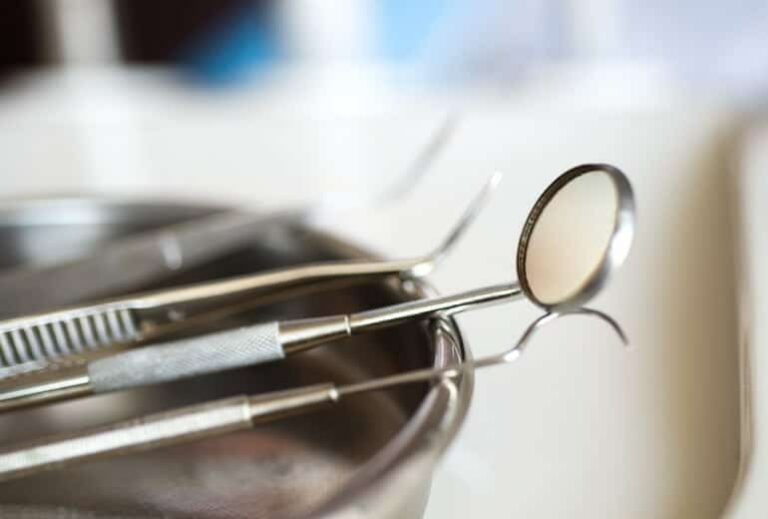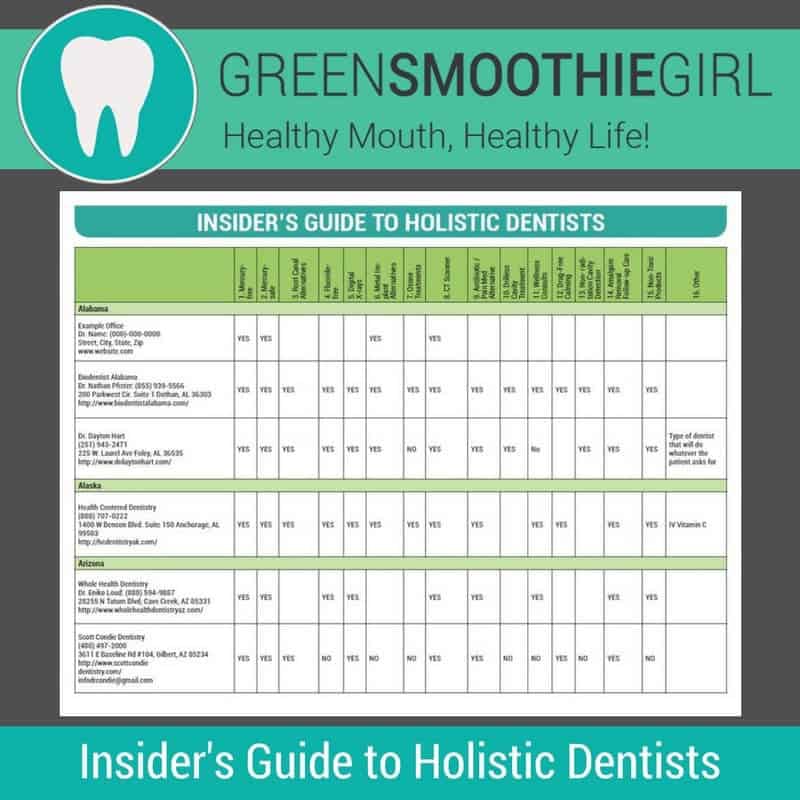Are Amalgam Fillings Safe? A Biological Dentist Weighs In

There’s growing evidence of safety problems with dental practices, like mercury in amalgam fillings, not to mention exposure for both the patient and dentist when fillings are being removed, when preserving dead teeth with root canals, during systemic fluoride treatments, and when using radioactive X-rays.
However, the exciting field of “biological” dentistry continues to deliver safer, non-toxic treatment options to patients who don’t want mercury bleeding into their brain or fossilized dead organs in their mouth.
The catch is only about 800 dentists nationwide are on board! It’s a growing movement we’re excited to educate you about here at GreenSmoothieGirl.
What are Amalgam Fillings?
In this article:
- Shifting to Biological Dentistry
- Can Amalgam Fillings Make You Sick? | Dr. Jorgensen’s Story
- What Are Dental Amalgam Fillings Made Of?
- Mad Hatters | From the Use of Mercury
- Why Do Dentists Still Use Mercury and Silver Amalgam Fillings?
- The Facts About Mercury In Modern Dentistry
- So…Are Amalgam Fillings Really Dangerous To Your Health?
- How Long Do Amalgam Fillings Last?
- What’s the Difference Between “Mercury-Free” and “Mercury-Safe” Dentistry?
Shifting to Biological Dentistry
My own dental saga and research led me to partner with my holistic dentist, Dr. Michelle Jorgensen, to create a 10-video masterclass that teaches you everything you need to know before your next dental visit, helping you avoid cavities, remineralize your teeth, and use the right products.

Find a biological dentist near you with our free Insider’s Guide to Holistic Dentists!
The state of your mouth’s health is a good indicator of your overall health! Let me explain.
Dr. Jorgensen | Holistic Dentistry
I have been fascinated by Dr. Jorgensen’s conversion from traditional dentistry to biological dentistry. I was there to watch the whole thing, and when I’d seen her make the full transition, already knowing her to be an outstanding practitioner, I moved my own family from my previous biological dentist to her practice.
Her education in and commitment to holistic dentistry stems from discovering that her own health issues were due in part to her regular contact with amalgam or “silver” fillings in her patients’ teeth.
I think you’ll find Dr. Jorgensen’s story very interesting, as well as her thoughts on mercury and other metals in amalgam fillings and the state of modern dentistry.
Can Amalgam Fillings Make You Sick? | Dr. Jorgensen’s Story

Dr. Jorgensen is my biological dentist and has experienced firsthand what mercury fillings can do to you.
My name is Dr. Michelle Jorgensen, and I am a second generation dentist. My father is a dentist and knew I wanted to be just like him. He is an avid runner and has been extremely healthy his entire career, and that’s what I thought all dentists were like.
Health Complaints
When I started to have nagging health issues about 15 years into my practice, I didn’t think it had anything to do with dentistry. Food sensitivities, numbness in my right hand and arm, forgetting things, my nose constantly plugged, difficulty breathing … what in the world could all of these things be from?
I took my family through Robyn Openshaw’s 12 Steps to Whole Foods program, and while we experienced many health improvements, and I’ll always be deeply grateful for that journey (we still eat the whole-foods diet), I began to suspect that my memory and other issues were from something related to my practice of dentistry.
Suspected Mercury Fillings
My health was declining so rapidly that I thought about leaving my practice. I emailed a colleague about my issues, and he said my email reminded him of himself, 10 years earlier. He suspected mercury toxicity. I was shocked. I had not placed a mercury filling for over 15 years. He asked if I removed mercury fillings in my practice. I did, every day! That was the beginning of my journey to become a biological dentist.
What Are Dental Amalgam Fillings Made Of?

Amalgam is 50% made of mercury, that toxic metal that negatively effects the systems in your body like neurologic, gastrointestinal, and renal.
Let’s step back. The first mercury dental filling material was made in France in 1816. A Frenchman mixed mercury with shavings from silver coins, forming a soft paste that could easily be packed into a hole in the tooth and shaped before it turned hard.
History of American Dental Fillings
This material was brought to the US in 1830 and was an instant success. This new filling material was inexpensive, easy to use, lasted a long time, and sealed the tooth fairly well. It became popular very quickly. That first filling material was 50% mercury (the liquid shiny stuff in thermometers) and 50% silver.
Are Mercury Fillings Still Used?
When I told a friend, who was a successful professional, about my health problems from mercury, he looked confused. “There's mercury in silver fillings?! They don’t put mercury in anymore, do they?”
I’m afraid so. In fact, 50% of those “silver” amalgam fillings is still mercury even today, with the rest made up of metals like silver, tin, and copper.
Mad Hatters | From the Use of Mercury

Hat makers used to use mercury to turn fur into felt. Repeated exposure eventually turned them mad, hence the term "Mad Hatter."
When this mercury and silver material was introduced, barbers did much of the dental work, and they loved these new fillings. They were easy to place, and they could make money on them.
The few doctors who did dentistry were not so excited about the mercury and silver combination. They knew the symptoms of mercury exposure from watching hatmakers.
Hatmakers Turning Fur into Felt
Hatmakers in that era used mercury to turn fur into felt. After repeated exposure to this mercury, the hat makers started showing bizarre behavior.
This is where the term “mad hatter” comes from – the mercury quite literally was making them crazy!
The doctors were concerned that mercury was being placed into teeth, but the barbers didn’t care. They were making money on these easy fillings. Mercury and silver fillings were here to stay.
Why Do Dentists Still Use Mercury and Silver Amalgam Fillings?
That is the background to dental mercury fillings, and they are still being used today in nearly 50% of dental offices in the US. Science and medicine have since confirmed that mercury is a poison to our system. In fact, mercury is the second-most toxic substance on Earth.

Dentists still use amalgam in their practices to this day.
Why are dentists still placing these fillings?
Ignorant of Adverse Health Effects
Recently, I talked to a dentist who graduated from dental school four years ago. I explained my concerns about my patients and myself breathing in mercury vapors as I remove old mercury fillings. He said he’d never heard anything about it. He didn’t know it could be a problem for patients or dentists.
Again, he only graduated four years ago. This is not new information, and yet, he was totally unaware!
It’s obvious the dental community at large doesn’t understand the problem and isn't educating new dentists appropriately, let alone the public.
The Facts About Mercury In Modern Dentistry
The safety of mercury fillings continues to be a very controversial subject. For your information, here are some undisputed facts:
- Mercury is the most neurotoxic, non-radioactive element on the planet. It is more neurotoxic than arsenic or lead.
- Dental researchers now concede that mercury vapor is released from unstimulated amalgam fillings 24 hours a day.
- Chewing, brushing, temperature increases, and clenching/grinding have been shown to release mercury vapor.
- The FDA and the American Dental Association promote amalgam fillings as a standard of care dentistry. Dentists who place amalgam fillings do so in good faith, believing in the efficacy, safety, cost-effectiveness, and longevity of amalgams.
- Sweden, Austria, Denmark, and Norway have all banned amalgam fillings.
So … Are Amalgam Fillings Really Dangerous To Your Health?
You must do your own research and decide what is best for you. When existing amalgam fillings are still functioning, it must be your personal choice whether to have them replaced with other materials, either for health reasons or if you want your teeth to look better.
How Long Do Amalgam Fillings Last?

Talk to your biological dentist about the procedures that can be used to remove your mercury fillings.
Even if you choose not to have them removed for health reasons, mercury fillings aren’t a permanent fix for a tooth. They have an average lifespan of 8-12 years.
Removal of Amalgam Fillings
How long have you had your old fillings? You most likely will need to have them replaced, and you need to know how to keep yourself safe when you do. A biological dentist has special equipment and procedures to keep you safe and also protect themselves during the removal process, so you aren’t breathing mercury vapors or swallowing the solids.
Holistic Dentist Finder
GreenSmoothieGirl has spent hundreds of hours contacting every “biological” dentist in the U.S., and they’ve put together this Holistic Dentist Finder.
Make sure you take a look at who is closest to you—and how many of my recommended 10 diagnostics and treatment options they use. (Not every biological dentist will have all of them, but the more the better! The typical dentist has 0, 1, or 2 of these protocols in place.)
What’s the Difference Between “Mercury-Free” and “Mercury-Safe” Dentistry?
I was a “mercury-free” dentist for 14 years. Now I am a “mercury-safe” dentist. There is a difference.
Mercury-free dentists don't place mercury fillings, but they still remove mercury fillings, and when they do, there aren't necessarily any safety measures in place.
The greatest exposure to mercury comes when the old filling is drilled out. Safe procedures used by mercury-safe dentists can reduce exposure by up to 90%.
When Robyn, “the GreenSmoothieGirl,” had her mercury fillings removed 20 years ago, she did so because she’d learned enough to know that mercury in her teeth was a bad idea. But back then, there was no such thing as a biological dentist. There are more of us now, learning how to safely remove fillings.
Robyn had her mercury fillings removed by a traditional dentist against his counsel—he disapproved and said it was a waste of her money—with no protective measures for her or him!
Amalgam Removal Procedures
What procedures do biological dentists use to remove amalgam fillings safely? Ten standards are generally regarded essential to be mercury-safe.
1. Keep it cool. To reduce mercury release, a lot of water is used to keep the filling cool.
2. Rocks, not pebbles. The filling is cut into large chunks, which reduces the amount of drilling.
3. Get it all out. The vacuum must be very strong and placed as close to the tooth as possible.
4. To breathe or not to breathe. Avoid breathing through your mouth during the procedure.
5. Dam it. A rubber dam won’t keep vapors out, but it will keep particles out of your mouth.
6. Clean up, clean up. Everything in the area and around the area should be rinsed very well.
7. Big vacuum. A very large vacuum is placed right below the chin.
8. Ions are friends. An ionizer traps any mercury still left in the air.
9. Rinse and spit. After the procedure, patients should rinse very well, even gargling in the back, and spit.
10. After the fact. Removing mercury fillings, even in a safe way, will always produce a temporary increase in a person’s exposure to mercury. Make sure all of your routes of elimination are clear and ready to do their job. The kind of mercury in dental fillings is detoxed through the urine, so make sure the kidneys are functioning well.
The Benefits of Practicing Mercury-Safe Dentistry
I am now using all of the mercury-safe procedures in my office, and things have started to look up for my health. That was the main source of my health problems, so I am dedicated to helping people avoid the path I had to take. I’m staying safe and keeping my patients safe from now on!
–Dr. Michelle Jorgensen’s practice, Total Care Dental, is in American Fork, Utah
Thank you, Dr. Jorgensen!
Watch our recent Facebook Live video where Dr. Jorgensen and I talk about alternative dental options for cavities, what to do about root canals, her favorite toothpaste, and more.
And jump in on our Healthy Mouth, Healthy Life video masterclass while it’s 80% off for our launch special! Dr. Jorgensen and I show you how to keep your teeth beautiful, strong, and white without compromising your health!
Want to find a biological dentist near you? Grab our free Holistic Dentist Finder! We called every dentist we could find in the U.S. who identifies as “biological” or “holistic,” and learned what services they provide.* We’ve indicated what they offer, and what they don’t, in this amazing free guide.
Do you have more questions about amalgam fillings and holistic dentistry? Ask them in the comments section below!
Up Next: Ridges, Bumps, Or White Spots In Your Fingernails? What Your Nails Say About Your Health

Disclosure: This post may contain affiliate links that help support the GSG mission without costing you extra. I recommend only companies and products that I use myself.
*No dentist paid to be in this resource. Please let us know if you know a biological dentist not represented here, as a minority of them did not return our calls, emails, and snail-mail.
Editor’s Note: This article was originally published on August 2, 2017, and has been updated for quality and relevancy. It was approved by Dr. Michelle Jorgensen, DDS, FAGD, TNC, and dental advisor for GreenSmoothieGirl.com. The information included here is not a replacement for professional diagnosis or treatment; please consult a holistic dental professional.
Posted in: Dental Health, Detox, Health Concerns, Holistic Care


















can a root canal every be reversed and healed after it has been done??? I have a lot of metallic tastes in my mouth from the kind of filling I have in my root canal and cavities.
Watch the Facebook live video linked in the post. Dr.Jorgenson addresses that question.
At Dr. Teeth in Houston where my dentist is they only use composite tooth-colored fillings. They said that mercury is toxic and should never be used in the mouth! I had my metal fillings removed for safer, tooth-colored fillings.
Its 2018 and dentists are still lying and telling the public mercury fillings are safe. These fillings are not safe and never have been and never will be ,dont ever get them !!!!! chemical processes can begin in your mouth that result in the production of electricity and increased offgassing of mercury rates,these fillings are not inert and with the occurrence of these chemical processes increased vaporization of mercury can be measured and electricity can also be measured coming from the fillings Dentists are not taught anatomy and failed to take into consideration that people breath they conduct their tooth filling procedures on dummies and dummies don’t breath .Any dentist telling you mercury fillings are safe is a dummy!!!!